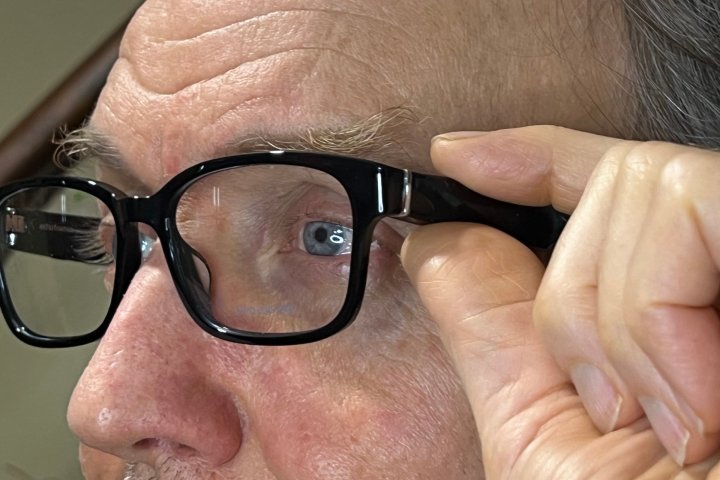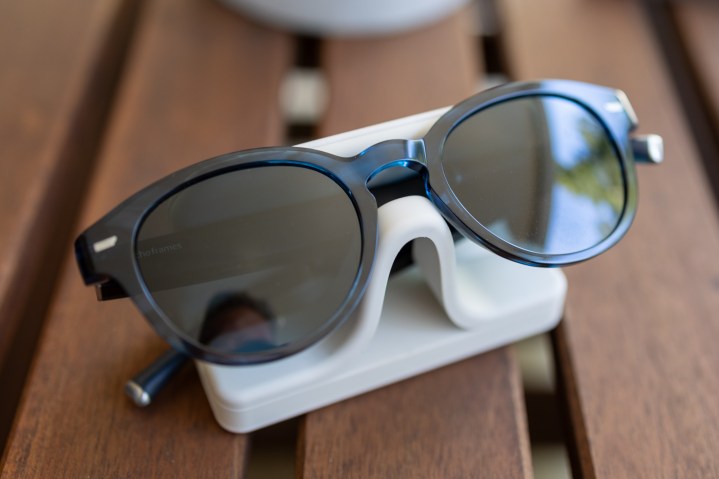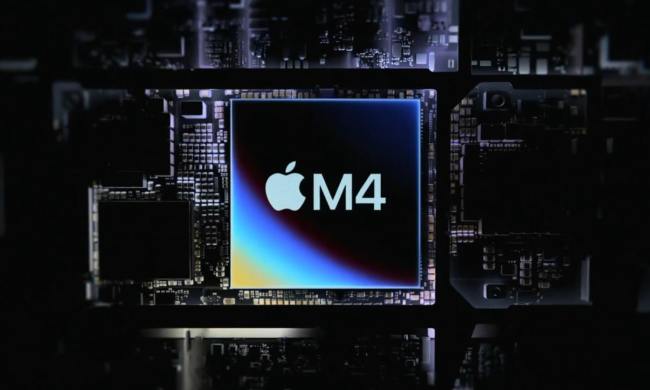“The Echo Frames are thinner, sound better, and come in a variety of options — all with the power of Alexa inside them.”
- Good volume with minimal leakage
- Nice audio quality for open-ear speakers
- Excellent call quality
- Access to the Amazon ecosystem
- Not locked in to a specific device
- No charging case
- Expensive compared to earbuds
The race to put computers on our faces continues. With the third-generation Echo Frames, Amazon recently updated its smart glasses with several refinements. There’s still no display, but the Amazon ecosystem is a compelling reason to consider this product if you’re in the market for a wearable that includes a full-featured digital assistant and a mobile app for smart home control.
Because Echo Frames are worn on the face like any other pair of smart glasses, there are special considerations, like appearance, comfort, battery life, and durability. My stereo speakers can securely rest in near-perfect safety on a shelf or nightstand, but smart glasses must withstand the challenges of portable devices.
We tested Amazon’s newest Echo Frames to find out how much they’ve improved, and whether there’s enough value to make these audio smart glasses a good buy.
Echo Frames design

Amazon reduced the thickness of the earpieces by 15% in the latest version of Echo Frames, making them even closer in appearance to normal glasses. They’re closer, but still noticeably thicker. With five frames and three lens options for each, there are plenty of choices in size and style.
I tested the prescription-ready (clear) lenses in the black rectangular frames. The gray version has black earpieces for a two-tone design. You also can pick frames that are square and black, blue and round, or brown and cat-eye.
Amazon Echo Frames look nice, and it would be hard for anyone to tell I was wearing smart glasses unless they looked closely at the earpieces. Thicker stems will be necessary for the foreseeable future to contain the electronics necessary to make glasses smart.
Each frame is of a different size, so check Amazon’s sizing guide before ordering. The largest glasses of this type are branded as Carrera smart glasses, but contain the same Amazon technology as the Echo Frames. You pay a little bit more, but sometimes larger is better for sunglasses.
The weight varies, but the Echo Frames I tested felt just like regular glasses. The weight is just a little over an ounce (38 grams), and the eartips are adjustable to fine-tune the fit. I could wear these all day with no complaints. My wife, who has small ears, also found them very comfortable.
Echo Frames audio quality

Because Echo Frames are audio-only smart glasses, good sound quality is essential. Amazon significantly improved audio in the third-generation wearable, doubling speaker volume, tripling the strength of bass, and improving microphone clarity.
I found the speakers to have good volume at slightly above 50%, so there’s room to get loud when my favorite jam is playing. Music seems crisp and vibrant. Bass is acceptable for such small speakers, but good-quality earbuds or headphones will still provide the best listening experience.
Despite the open-ear design of Echo Frames, sound leakage is minimal. That was a problem with earlier versions of Amazon smart glasses. I had to make the volume uncomfortably loud for anyone nearby to hear what song I was playing. The sound control is similar to the quality of Ray-Ban Meta smart glasses, which also limit audio dispersal.
Amazon also greatly improved microphone quality in the third-generation Echo Frames. The company claims up to 10 times better voice recognition. That’s useful for interacting with voice assistant Alexa and also helps with calling.
I tested calling in a room with a small fan and a heat pump that runs continuously in the winter. The noise isn’t overwhelming, but my Apple Watch indicates it’s 45 decibels. I can speak normally, and that background sound is eliminated. I swapped with the caller to hear it for myself.
Amazon also is aware of privacy concerns with wearables. If I want to be certain I’m not heard by Alexa, it’s easy to toggle the mics on or off with a double-click of the front right button. Also, the Echo Frames sleep as soon as I fold them and wake within about 10 seconds of putting them on.
Echo Frames and Alexa

Another key feature of audio smart glasses is the personal digital assistant. For Amazon, that means Alexa, a well-established, voice-controlled assistant.
Alexa has been helping Amazon customers manage their low-cost Echo speakers, Kindle Fire tablets, and Kindle e-readers for many years. If you know how to use Alexa on a speaker or a Kindle, you’ll feel right at home with Echo Frames.
I can set timers and alarms, make notes, add items to lists, and ask about local information or general facts. Alexa will draw data from various websites to supply answers. It’s not perfect, but the Echo Frames respond with useful answers much more often than Siri does on an Apple HomePod.
Echo Frames can read notifications. That could become overwhelming, so Amazon includes a customizable filter — it’s literally called “VIP Filter” — to select which people and apps you’d like to hear from. The Alexa app also will handle any firmware updates.
Alexa isn’t as conversational as ChatGPT, but that should change when Amazon’s AI chatbot rolls out. A preview of this capability, “Let’s Chat,” is coming soon.
Integrations

Amazon has a robust ecosystem that I can access with the Echo Frames. You don’t have to be a Prime member to take advantage of Kindle eBooks, Amazon Music, and Amazon shopping.
There’s plenty of free content to listen to. I asked Alexa to read me a book from my Kindle library and was pleased with the voice quality, even though it lacked the emotion of a human reader.
For Amazon Music, I can select specific songs from my library. Even if you don’t subscribe to this service, you can request 1980s classic rock, dubstep, electric blues, or any other genre and listen to free radio playback ofsongs of that type.
The Echo Frames smartly put Alexa directly in your ears.
Echo Frames also allow control of any smart devices with Alexa compatibility. I tested this with a smart light to change its color and brightness, plus switch it on and off. If you use smart devices in Alexa Routines, you can control multiple devices with a single command.
The smart glasses also serve as a Bluetooth headset, so any sound I play on my iPhone comes to Echo Frames. Echo Frames can connect to two devices and automatically switch to the most recent audio playback. I can connect to my iPhone and PC, seamlessly switching within a couple of seconds.
As great as these Amazon services are, having a choice is always nice. Echo Frames can be connected to other digital assistants and alternate music providers. When paired with my iPhone, I can use a long press on the right rear button to access Siri and connect to Apple Music. I also tested with Android, playing songs on Spotify and asking Google Assistant for information.
Echo Frames battery life

Because Echo Frames serve as earbuds in a convenient glasses form, battery usage is minimal. I charge all my portable devices every night, and the Echo Frames battery never fell below 50%.
Amazon claims you can use Echo Frames for up to 14 hours with moderate usage, which is 40% longer than the previous generation. That estimate matches my experience, but it’s best to expect you’ll need to charge these smart glasses daily. The Alexa app also lets you enable a low-power mode that disables the Echo Frames’ ability to listen for you to say “Alexa” or “Echo” to activate them.
If you play audio continuously, that could drop to 6 hours. Amazon includes a charging dock (completely with USB-C connector) that fully replenishes the battery in 2.5 hours, so you can top up during the day.

The charging base can take a little getting used to. Amazon does a decent job explaining in the included quick-start guide that the lenses need to face upward in order for the Echo Frames to charge, but it could have been a little more specific in how to maneuver the glasses onto the base. The short version is that you’ll want to close the right-hand temple all the way to the frames, and leave the left-hand temple mostly free as you rest the nose pads on the bridge of the base. If it feels like you have to force anything, you’re doing it wrong. A hidden LED will change from flashing white to orange if you get it right; it’ll flash red if you missed.
A charging case — like what you get with the Ray-Ban Meta glasses — would be nice for portability, and it would remove any concerns about using these when on the go.
Should you buy Amazon Echo Frames?
The bottom line is value. Amazon currently charges $195 for the least expensive third-generation Echo Frames, but the regular price is $270 (that’s typical for most Amazon products). That’s expensive compared to the 2023 Amazon Echo Buds that retail for $50. Echo Buds have virtually the same features and include a charging case to extend battery life to 20 hours.
If you don’t like earbuds, the Echo Frames are a nice alternative. I find them to be as comfortable as sunglasses and as attractive as sunglasses or prescription frames. The open-ear design makes it easy to speak with friends and family without having to pause to take out an earbud or switch to transparency mode.
If you are looking for smart glasses that include a screen, I recently compared three top display smart glasses brands, so that might be worth a look. Echo Frames are an intriguing option if you’re looking for new glasses. However, if these smart glasses are beyond your budget, you might want to add them to an Amazon wish list.





